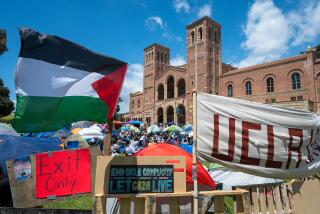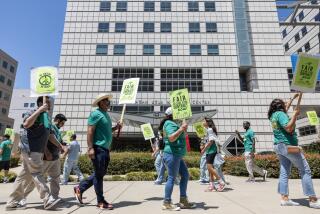UCLA Mobile Clinic Project benefits both sides of the clipboards
As a warm summer evening takes hold, a white delivery truck rolls to a stop at a West Hollywood corner and is joined by a throng of T-shirt clad students. Within minutes a street scene springs to life, full of pop-up canopies, tables, folding chairs and young faces in motion.
This is college night â of a different kind.
Every Wednesday, UCLA students studying medicine, law and public health transform a nondescript section of sidewalk near Romaine Street and North Sycamore Avenue into an open-air health clinic and help center for the homeless. Itâs also a training ground where clinical skills and compassion are practiced in equal measure.
âWeâre here where they feel most comfortable,â said Kevin Norris, one of the programâs undergraduate coordinators.
The volunteer, student-run Mobile Clinic Project at UCLA, funded by grants and donations, represents a unique collaboration across disciplines, providing training for undergraduates and professional school students alike.
For a decade, the group has operated just down the street from a food truck run by its partner, the Greater West Hollywood Food Coalition. In this one place, the homeless can find a hot meal, medical and legal services, and a welcoming respite from the loneliness of the streets.
A team of 30 students creates a kind of field clinic â setting up tables for boxes stuffed full of client files, unfolding green camping cots and stringing blue tarps around them to create private exam rooms.
Most of the interaction takes place on folding chairs, where medical students conduct physical exams. Undergraduate caseworkers with clipboards sit at their feet asking questions to piece together health and social histories.
Eric Tam, a fourth-year neuroscience undergraduate, drove the truck this day and says the work is motivating and illuminating. âItâs not just health, youâre learning about life in general.â
Their clients are gay and transgender, HIV-positive, meth addicts, veterans. Itâs a mix that helps the future doctors and health professionals cultivate a sense of common humanity with an array of patients, said Walter Coppenrath, a family medicine doctor with Kaiser Permanente and one of the groupâs professional advisors. It makes them âmuch more comfortable in uncomfortable situations,â he said.
One of the first clients to arrive is Rodney Brackin, 48, a regular for the last eight months. Today, he has a sore arm. Speaking haltingly with a slight stutter, Brackin says he likes to talk to the students about TV shows and movies. Brackin rarely has a medical need, he just likes the studentsâ company, Coppenrath said.
The students check blood pressure, dispense medication and search for lice. But their primary objective is to connect clients with conventional health centers, including the Step Up on Second mental health facility and Ocean Park Community Center in Santa Monica, the Saban Free Clinic in Los Angeles and the Venice Family Clinic. The students provide bus tokens and taxi vouchers to help their clients get there.
The team usually sees 25 clients in a night. An additional 40 people may come for a hygiene kit â small essentials like shampoo, toothbrushes, vitamins.
Inside the open truck, students staff a counter lined with drawers of supplies and medication. They field their teammatesâ requests for antibiotics and topical ointments, asthma and hypertension medication. Donations are piled against another truck wall, boxes and backpacks full of clothes and toiletries. Today, they set out a table with several pairs of shoes.
Nearby, law students and an advising attorney sit at a table with laptops and a printer, guiding clients through such issues as eviction notices, court appearances and how to pay for tickets by performing community service. Managing legal problems can allow clients to better focus on their health, organizers say.
For students, the street clinic offers a change of pace from the classroom, and practical â if at times chaotic â field experience. âYouâre trying to listen to their heart, to their lungs, and thereâs street noise, thereâs conversations going on,â said Boba Benghaly, a second-year medical student. Compared to the projectâs other indoor venues, such as Step Up on Second, she said, the sidewalk setup âis the most challenging, the most energetic.â
By 9 p.m., the team members wrap up their work and reload the truck. They form a circle under a street lamp, pass around a super-sized bottle of hand sanitizer and recap the frenzied evening. Thereâs an initiation tradition: New members introduce themselves and bust a favorite dance move.
Then the students disperse, chattering as they head toward their cars. Brackin, the last lingering client, heads the other direction and disappears around a corner.
More to Read
Sign up for Essential California
The most important California stories and recommendations in your inbox every morning.
You may occasionally receive promotional content from the Los Angeles Times.










